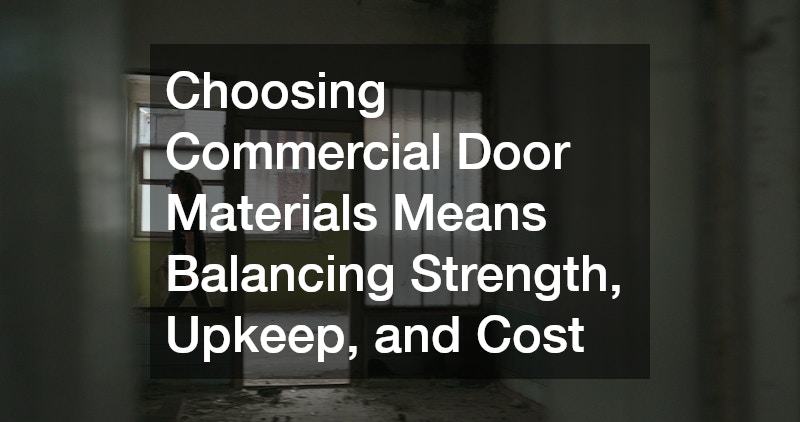The Best Materials for Long-Lasting Commercial Doors
Choosing the right materials for commercial doors is critical to ensuring their durability and longevity. These doors are subject to frequent use, and the materials affect not only their lifespan but also their functionality and maintenance requirements.
In commercial settings, doors must withstand heavy traffic and adverse conditions while maintaining their integrity. Material selection impacts not only how long the doors last but also how well they can withstand various stresses without significant degradation.
Investing in high-quality materials can reduce long-term costs and enhance safety, making the selection of durable materials a pivotal decision for businesses. This article explores the best materials that offer long-lasting benefits for commercial doors.
What Are the Most Durable Materials for Commercial Doors?
Steel: Strength and Security Benefits
Steel doors are praised for their exceptional strength and security benefits. Heavy-duty and formidable, these doors can withstand intense wear and tear, making them ideal for high-security venues.
Steel’s intrinsic properties resist deformation under stress, which is crucial for maintaining door functionality over time. Additionally, the inherent durability of steel contributes to its effectiveness in deterring potential break-in attempts.
Commonly embraced in industries demanding robust security measures, steel doors provide peace of mind with their resilience. They require minimal maintenance to retain their protective qualities and structural soundness.
Fiberglass: Advantages in Tough Conditions
Fiberglass doors excel in areas prone to harsh environmental conditions due to their tough, resilient nature. These doors offer excellent resistance to moisture, which makes them suitable for locations with high humidity or exposure to water.
The durability of fiberglass ensures longevity even in environments that experience significant temperature fluctuations. Moreover, fiberglass doors do not warp or crack easily, maintaining their appearance and functionality over time.
In addition to their resilience, fiberglass doors are energy-efficient, offering superior insulation properties that help in temperature regulation within commercial spaces. This energy efficiency can contribute to cost savings over time.
How Do Material Choices Affect Maintenance Needs?
Wood: Balancing Beauty with Maintenance
Wooden doors offer a timeless aesthetic appeal, characterized by their warmth and elegance. However, maintaining wooden doors can be labor-intensive due to their susceptibility to moisture and pest damage.
Regular varnishing or painting is necessary to protect wood from weathering and to preserve its appearance. The necessary upkeep for wooden doors must be factored into maintenance budgets, as neglect can lead to significant deterioration.
Despite the maintenance needs, wood remains a popular choice for those valuing its distinctive charm. It’s important to balance its beauty with the commitment to regular maintenance to ensure its longevity.
Aluminum: Low-Maintenance Appeal
Aluminum doors present a low-maintenance option for commercial properties, owing to their resistance to corrosion and rust. These doors are particularly suited for businesses aiming to minimize ongoing upkeep requirements.
The lightweight nature of aluminum allows for easy handling and installation while still maintaining durability. For businesses, this means lower costs associated with repair and replacement over time due to the material’s resilience.
Aluminum doors are available in various finishes, providing versatility and aesthetic variety without compromising on durability. They offer an optimal balance between functionality and minimal maintenance, making them a preferred choice.
What Are the Cost Considerations for Different Door Materials?
Initial Costs vs. Longevity of Materials
Understanding the trade-off between initial costs and the longevity of door materials is crucial for commercial applications. While materials like wood might offer aesthetic value, they can be more costly initially and over time due to maintenance.
Steel and fiberglass, though potentially higher in upfront cost, often provide better value long-term through durability and lower maintenance needs. Investing in materials that require less frequent replacement can offset initial expenses.
Businesses must evaluate the full lifecycle costs of door materials to make informed decisions. Choosing durable materials can lead to cost savings while ensuring longevity and performance.
Budgeting for Maintenance and Repairs
It’s important for businesses to incorporate maintenance and repair costs into their budgets when selecting door materials. Materials like aluminum, which have lower maintenance demands, can lead to cost savings in the long run.
Regular upkeep and repairs should be anticipated and factored into the overall financial plan to prevent unexpected expenses. Budgeting for these aspects can help in managing the total cost of ownership for commercial doors.
By planning for the long-term financial implications of maintenance and repairs, businesses can make more strategic decisions. Such foresight ensures that resources are appropriately allocated for the upkeep of commercial properties.
Choosing the best materials for commercial doors hinges on a balance of durability, maintenance demands, and cost considerations. Understanding these factors is vital in making informed decisions tailored to specific commercial needs.
While some materials promise remarkable longevity and low maintenance, others require more frequent care yet offer unmatched beauty and aesthetic value. Each choice carries unique advantages that must align with business priorities.
The proper selection of materials can significantly enhance the functionality and lifespan of commercial doors, ultimately leading to operational efficiency and long-term cost savings. Investing in quality materials is a decision that will benefit commercial enterprises for years to come.

